|
The Sausage Saga, part 6: God Save The Wurst -
The world of English and Scottish sausages
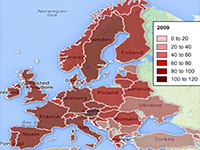
Meat consumption per capitas. |
In June 2013, The Guardian published an
article summarizing the consumption of meat on a global scale.
Although the numbers do not specifically mean the consumption of sausage but meat
and meat products as a whole, the biggest cranivores in the world are - not surprisingly -
the Americans who devour 127 kilos (280 lbs) of met per capita per year (2007 number).
The second is Australia with 111 kilos (2009 number). The surprise number
is which country comes third. One would think the British with all the roastbeef and sausage,
or the Germans with all that bratwurst, or the Kazakhs, who have a reputation that
there only wolves eat more meat... No. It is the Austrians, who consume 102 kilos of meat
per capita (2009 number). In Europe, Austrians are by far the most voracious carnivores
(must be the Wienerschnitzel, the Saftgulasch and the Wiener Würstchen... The UK, along
with Ireland, Germany, Czech Republic and France fall in the 80s. Portugal, Spain, Italy
and Denmark put away more meat (90s), but the absolute first in Europe is Austria:
102 kilos (225 lbs) of meat for every Austrian large or small, toddler or old, per year.
According to research by the British Sausage Association Society,
81% of Brits agree that sausages provide a good value family meal,
85% of Brits agree that sausages are a convenient meal choice,
86% of Brits agree that sausages are suitable fora variety of different meals from breakfast to dinner.
The peak day for sausages to be eaten is Saturday. The majority are eaten as an evening meals.
There is only one thing more British than the banger (= sausage, to non-Brits): tea.
Bangers occupy the number two spot Brits miss when they travel outside the country.
I fact, wurst is Britain’s single most popular choice for dinner:
864 million meals eaten in a year feature the mighty sausage, translating to
2.3 million people devouring sausage for their dinner each day
The English wurst beats even such traditional bastions of English cuisine as
curry and fish and chips! As British comfort foods go, weenies come in third behind
chocolate and ice cream. The most popular type of sausage is the plain pork
sausage, which accounts for over 40% of sales, with the Cumberland sausage (13%) finishing second.
In a year, almost 200,000 tons of wurst are eatenin in England, about 4x the weight
the RMS Titanic!
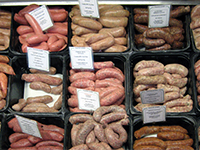
English sausages. |
There are more than 470 types of bangers in Britain. The nickname "banger" dates back to
WWII, when English sausages were made so full of water that they would tend to explode when fried.
470 varieties of bangers sounds high, but compare that to the 1,500 varieties of wurst produced in Germany).
In all, in the U.K., Ireland and Germany, and to a lesser extent in Austria, Hungary,
Poland or the Czech Republic, the wurst isn’t just a national dish; it is a way of life.
A good English sausage should be made with at least 70% high quality meat,
usually beef or pork or a mixture of both. The remaining content is seasoning and breadcrumbs.
Across the UK there are many regional varieties of sausages:
- Cumberland Sausage - a hefty, chunky sausage easily identified as it comes in a continuous spiral,
seasoned with pepper
- Gloucester Sausage - made with Gloucester Old Spot Pork, flavored with sage
- Lincolnshire Sausage - herby and meaty, often heady with sage and sometime a little thyme
- Suffolk Sausage - coarse sausage similar not unlike a Lincolnshire
- Manchester Sausage - herby sausage containing cloves, ginger, nutmeg, mace and white pepper
- Marylebone Sausage - traditional London sausage, seasoned with mace, sage and ginger
- Oxford Sausage - sage and savory, a touch of marjoram, lemon pork and veal - a nicely refined sausage.
- Pork and Apple - pork sausage with apple, a lovely moist sausage
- Yorkshire Sausage - a sausage flavored with cayenne pepper, a pinch of nutmeg,
white pepper and mace

Cumberland sausage. |
Cumberland sausage is a sausage from the historic Cumberland County in northwest England.
It is made of pork and traditionally made very long (up to 50 cm), and sold rolled in a
coil. Sometimes they are made shorter, like ordinary British sausages,
and sometimes they are coated in breadcrumbs.
The meat is pork, chopped instead of ground, , giving the sausage a chunky, meaty texture.
Seasonings are dominated by pepper, both black and white, in contrast to
the more herb-dominated flavors of Lincolnshire sausage.
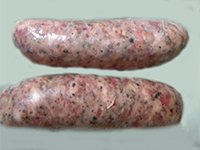
Raw Lincolnshire sausage. |
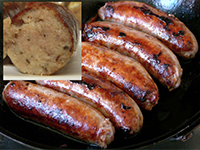
Pan-fried Lincolnshire sausage. |
Lincolnshire sausage is a pork sausage from the east of England. The meat is coarsely ground,
seasoned with sage and stuffed in natural pork casing. Other herbs such as parsley and thyme are often used,
but these are not considered authentic for Lincolnshire sausages. Unlike the Cumberland sausage,
there is no standard width or length for a Lincolnshire sausage.
The Lincolnshire sausage is
as integral part of the traditional English breakfast.
Efforts to standardise and control the manufacture of Lincolnshire sausages
have resulted in a proposed ingredients list:
- British pork, coarse cut, minimum meat content 70%
- Maximum fat content 25%
- Breadcrumbs
- Sage, salt and pepper
- Pork-intestine casings
- Sulphite preservative (to 450 ppm maximum)
Unlike the Cumberland sausage, there is no standard width or length for a Lincolnshire sausage.

Cooked Newmarket sausage. |
The Newmarket sausage is a pork sausage, moderately spicy, originating from the English town of Newmarket in Suffolk.
There are several different brands of Newmarket Sausage, which differ in theuse bread as a filler
vs. rusk (baked bread). They also vary in the proprietary seasoning mixes they use.

Downtown Newmarket in the late 19th century. |
The brand Musk's originated in the small village of Stetchworth, three miles from Newmarket,
sometime in or before 1884.
Elizabeth Drake and James Musk in Depford are credited with the creation of this sausage.
The family business continues to this day. Musk's sausages have been favored by royalty,
and Royal Warrants were issued to Musk's from George V in 1907, Prince Edward of Wales
(later the Duke of Windsor) in 1929, Queen Elizabeth in 1965, and Queen Elizabeth II in 2005.
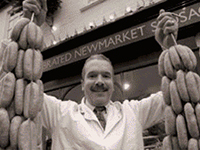
Powter's sausages. |
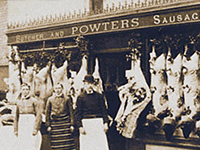
Powter's sausages. |
The second trademark is Powters, based in Newmarket. Their recipe dates back to 1881.
Using meat from their own farm, which is free-range and hand-bones,
they use their secret family recipe dating back to that year.
Their sausage is made from minimum 80% meat, which consists of prime cuts such as the loin and the leg,
no trim and by-products.
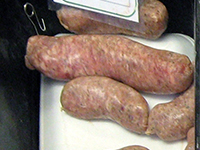
Raw Oxford sausage. |
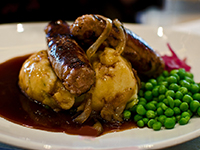
Oxford sausage and mash. |
Oxford sausages are a distinctive variety of pork and veal sausage commonly associated with,
and thought to have been developed in, the city of Oxford. Traditionally, Oxford sausages
are noted for the addition of veal, in contrast to many traditional British sausages,
which contain only pork, and their high level of spice seasoning. References to the "Oxford"
style of sausage date back to at least the early 18th century.
The first published reference to a sausage that closely resembles the present-day Oxford sausage
is by John Nott in " The Cook's and Confectioner's Dictionary:
Or, the Accomplish'd Housewife's Companion" published in London in 1723.
Oxford sausage is a regional food product. Therefore, unlike for example German bratwursts that
can be called, for instance, Coburger Bratwurst only if they are made in Coburg, the Oxford sausage
does not face such a restriction. Different recipes for Oxford sausages vary in many aspects,
but all follow a similar ingredient list. The modern Oxford consists of a mixture of pork and veal,
seasoned with lemon and herbs. Nott's 1723 recipe calls for pork or veal,
seasoned with salt, pepper, clove, mace and sage. The spice content also appears in many other
late 18th and early 19th century recipes, with mace or nutmeg (derived from the same seed)
being a consistent ingredient. When first produced, Oxford sausage did not have a casing,
but was hand-formed and flour-coated before frying. Modern forms are commonly made in a conventional
linked banger style with natural pork or sheep casings.

Raw Gloucester sausage. |
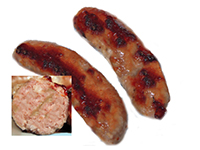
Pan-fried Gloucester sausage. |
The Original Gloucester is a large pork sausage with a blend of herbs and apple.
Meat comes from the Gloucestershire Old Spot pig breed. These are big pigs indeed.
Boars reach around 600 lbs, while Miss Piggy is slender, only about 500 lbs...
Meat content in the Gloucester Sausage is 70-80%. Bread is used as a binding
agent instead of rusk. The taste is peppery, herby and succulent.
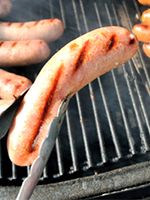
Yorkshire sausage on the grill. |
If you have ever wondered what was missing from your last Yorkshire breakfast or
your last serving of bangers and mash, the answer is: Yorkshire Sausage! Lincolnshire, Cumberland
and Suffolk all have distinctive sausages named after them; sausages that are rooted in their
local history and celebrated across the UK. But Yorkshire, the biggest county in the UK has not had
a a namesake sausage. In a bid to give the sausage lovers of Yorkshire a banger they can be proud of,
David Lishman, an award-winning butcher from Yorkshire, organized a campaign to give
Yorkshire its own sausage.
If this counds similar to the story of Kurt Zeitler, the mayor of Würzburg, whose principal
achievement was the creation of the official Würzburger bratwurst, it is.
In a grass-roots banger-eating roadshow, the "official Yorkshire sausage" was chosen
by public opinion:
Seasoning:
- 135g salt
- 27g white pepper
- 19g nutmeg
- 19g mace
- 19g ground coriander
- 19g dried parsley
Total 238g seasoning
Meat
- 6.8 kg pork shoulder & belly
- 672g pinhead rusk or dried breadcrumbs
Method:
- Grind the pork through a 5-mm mincer plate.
- Add the seasonings and bread or rusk
- Add water to rehydrate the bread or rusk (approx 1.3kg)
- Grind a second tie for a second time.
- Fill into natural pork-intestine casings.

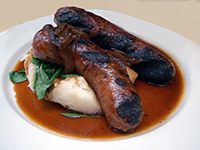
Typical bangers and mash. |
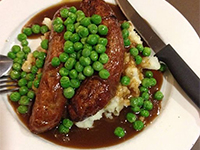
bangers and mash with peas. |
Man obviously does not survive on weenies alone. The English wurst needs a partner in crime
to truly achieve greatness.
Mashed potatoes are the most popular plat d'accompagnement, followed by
chips (= french fries to Americans), beans in tomato sauce, and fried eggs.


Traditional haggis in a sheep stomach. |

Haggis sausage mixture in a can. |
Writing about british wurst, one cannot omit a word or two about Scotland, and obviously,
about Haggis. This is a savory Kochwurst made with sheep's pluck (heart, liver and lungs);
finely ground with onion, oatmeal, aw fat, spices, and salt, mixed with stock.
It is traditionally encased in the sheep's stomach and simmered for approximately three hours.
Most modern commercial haggis is prepared in a sausage casing rather than an actual stomach.
As the 2001 English edition of the Larousse Gastronomique puts it,
"Although its description is not immediately appealing, haggis has an excellent nutty
texture and delicious savoury flavour".
Haggis is a traditional Scottish dish, considered the national dish of Scotland as a result of
the poem "Address to a Haggis" written in 1787 by Robert Burns, the national poet of Scotland.
Fair fa' your honest, sonsie face,
Great chieftain o' the pudding-race!
Aboon them a' ye tak your place,
Painch, tripe, or thairm :
Weel are ye wordy o'a grace
As lang's my arm.
The groaning trencher there ye fill,
Your hurdies like a distant hill,
Your pin wad help to mend a mill
In time o'need,
While thro' your pores the dews distil
Like amber bead.
His knife see rustic Labour dight,
An' cut you up wi' ready sleight,
Trenching your gushing entrails bright,
Like ony ditch;
And then, O what a glorious sight,
Warm-reekin', rich!
Then, horn for horn, they stretch an' strive:
Deil tak the hindmost! on they drive,
Till a' their weel-swall'd kytes belyve
Are bent like drums;
Then auld Guidman, maist like to rive,
Bethankit! hums.
Is there that owre his French ragout
Or olio that wad staw a sow,
Or fricassee wad make her spew
Wi' perfect sconner,
Looks down wi' sneering, scornfu' view
On sic a dinner?
Poor devil! see him owre his trash,
As feckless as wither'd rash,
His spindle shank, a guid whip-lash;
His nieve a nit;
Thro' bloody flood or field to dash,
O how unfit!
But mark the Rustic, haggis-fed,
The trembling earth resounds his tread.
Clap in his walie nieve a blade,
He'll mak it whissle;
An' legs an' arms, an' heads will sned,
Like taps o' thrissle.
Ye Pow'rs, wha mak mankind your care,
And dish them out their bill o' fare,
Auld Scotland wants nae skinking ware
That jaups in luggies;
But, if ye wish her gratefu' prayer
Gie her a haggis!
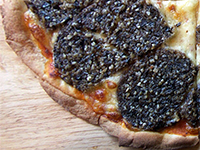
Pizza with Haggis at Aberdeen airport. |
Haggis is traditionally served with turnip and potatoes, boiled and mashed separately,
and a glass of Scotch whisky. However, in the 21st century, haggis has made it onto the stage of culinary fusion.
In Scotland, there is even haggis pizza, as seen in a restaurant at Aberdeen airport.

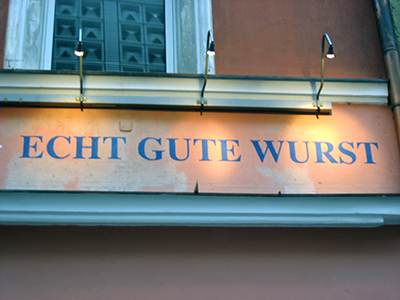
Sources:
- Exhibit "Sousedé na talíři, Die Nachbarn auf dem Teller" held 2011 - August 2011 in Brno, Czech Republic
- Exhibit "British Sausage Week 2012"
- The Great British Sausage Report, compiled by The British Sausage Appreciation Society, 2012
- Lincolnshire.org
- Wikipedia
back to Radim and Lisa's Well-Travelled Cookbook | email us
Last updated: May 10, 2014
Certain images from Wikimedia Commons, used under the terms of the GNU Free Documentation License.
|























